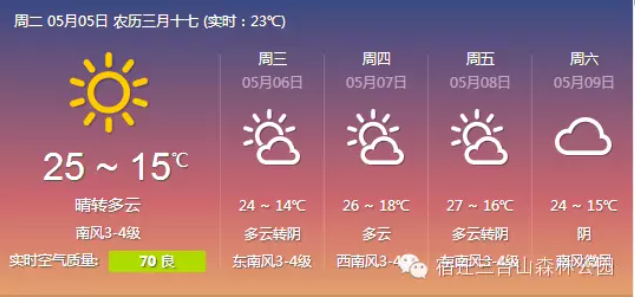Travel Emergency response Manual
prompt:Click on the aboveSuqian Santaishan Forest ParkOne-click focus. The article is reproduced from Wuxi Youth Brigades
Nowadays, tourism activities are becoming an important part of People's Daily life. However, there are all kinds of foreseeable and unforeseeable safety risks in the process of tourism activities. In order to enhance the safety awareness of everyone to go out to play, improve self-help and mutual rescue ability, prevent and defuse tourism safety risks, must carefully read yo ~~~
1Emergency response to natural disasters
1.1 The flood
1.1.1 When the flood comes, you should take shelter in the nearby hillside, highland, roof, high-rise building, tall tree and other places.
1.1.2 Try to send out the distress signal and information as soon as possible, report their location and danger situation, and actively seek rescue.
1.1.3 When falling into the water, look for and hold floating objects, such as door panels, tables and chairs, wooden beds, large pieces of foam, etc.
1.1.4 When the car enters the flooded area, it should pay attention that the water level should not exceed the cab and drive to the high ground against the flood, so that the flood cannot impact the car body from the side.
1.1.5 Don't lose your head and yell; Do not approach or climb the poles or pylons. Do not climb onto the roof of a mud house.
1.2 The earthquake
1.2.1 After the earthquake, in the room, to choose easy to form a triangular space to avoid, can hide in the inner corner or more pipes, good integrity of the bathroom, storage room and kitchen, etc. Do not hide under the exterior window, elevator, not to jump off a building.
1.2.2 In public venues, quickly "squat, cover and hold" nearby or hide near pillars and large objects; When you are in the doorway, you can quickly run out of the door to the open field; While upstairs, look for opportunities to gradually move to the ground floor.
1.2.3 Outdoors, keep away from narrow streets, tall buildings, tall chimneys, transformers, glass-walled buildings, viaducts and places where dangerous goods and inflammable goods are stored.
1.2.4 In a moving car, tram or train, the passenger should hold the handrail firmly to avoid falling, lower the center of gravity, hide near the seat, do not jump off the bus, and get off after the earthquake.
1.2.5 Cover mouth, nose and head with wet towel, clothes or other cloth to prevent choking due to dust choking.
1.2.6 Find and open channels and move towards bright and spacious places; Don't take the elevator to escape.
1.2.7 Unable to get out of danger at the moment, we should save energy and lie still to maintain physical strength; Don't shout blindly for help; Move your hands and feet to remove dirt from your face and pressing things on your body.
1.2.8 Wherever possible, try to protect your head with a quilt, pillow, schoolbag or other soft object.
1.3The tsunami
1.3.1 Earthquake is the earliest signal of tsunami. There is a time difference between earthquake and tsunami, so we should take advantage of the time difference to avoid danger and escape.
1.3.2 Evacuate immediately in case of sudden abnormal tide fluctuation, significant sea level drop or huge waves.
1.3.3 Before the tsunami, many sea creatures like fish and shrimps are often left in the shallow when the sea recedes abnormally, which is a magnificent scene. However, at this time, do not pick up fish and shrimps or watch the scene. Instead, quickly leave the coast and move to the high land.
1.3.4 Unfortunate fall of tsunami:
1.3.4.1 Try to catch large floating objects and avoid collision with other hard objects.
1.3.4.2 Do not raise your hand or struggle in the water, but try to reduce your movements. You can float on the water and drift with the waves.
1.3.4.3 Do not take off your clothes when the sea temperature is too low.
1.3.4.4 Try not to swim in case the body heat is lost too quickly.
1.3.4.5 Do not drink sea water, sea water can not quench thirst, but people will have hallucinations, leading to mental disorders and even death.
1.3.4.6 Try to get close to other drowning people, so as to enlarge the target for rescuers to find.
1.4 Debris flow, landslide
1.4.1 When debris flow and landslide are found, flee to the stable area on both sides quickly. Do not run along the mountain to the top or the bottom.
1.4.2 Don't hide under a hill with Rolling Stones and piles of debris.
1.4.3 Do not stay in low-lying areas and do not climb trees for shelter.
1.4.4 Always try to get out of the house into the open.
1.4.5 Choose flat, high ground for your camp. Do not camp in valleys or at the bottom of gullies.
1.5 The typhoon
1.5.1 Move to a strong building or ground floor as soon as possible to avoid wind and rain.
1.5.2 Avoid going out, wear more colorful clothes when you must go out, and walk in a place where you can hold fixed objects at any time.
1.5.3 When walking outside, try to bend down to curl your body into a ball, fasten your coat buttons, and crawl forward when necessary.
1.5.4 Do not swim or sail on typhoon affected beaches.
1.6 A tornado
In the interior:
1.6.1 Stay away from doors, Windows and the outer walls of the house. Hide in the wall or small room opposite to the direction of the tornado and keep your head down. Try to avoid using the telephone.
1.6.2 Cover your body with a mattress or blanket to avoid injury.
1.6.3 Basements or semi-basements are the safest hiding places.
Outside:
1.6.4 Do not stay on the open roof, enter the ground floor of the concrete building nearby.
1.6.5 Stay away from trees, telephone poles or simple houses.
1.6.6 Run fast in the direction perpendicular to the tornado's path.
1.6.7 If you have no time to escape, you should quickly find the low-lying land and lie down.
1.6.8 Do not dodge in a car or in a car.
1.7Thunder and lightning
1.7.1 Avoid thunderstorms in the wilderness, in a lonely hut, under an isolated tree, by a telephone pole, or on a high slope.
1.7.2 Do not stand barefoot on concrete, do not take a bath or shower, do not use a landline telephone, and do not use a radio or TELEVISION with an external antenna
1.7.3 Stay away from railway tracks, long metal railings and other large metal facilities. Avoid standing on hilltops, commanding heights and other places.
1.7.4 When more than one person are in the wild, keep a certain distance from each other and do not crowd together.
1.7.5 Rubber soled shoes or rubber tires cannot resist lightning.
1.8Dust storms
1.8.1 Wear masks and scarves outside.
1.8.2 Drink plenty of water and eat light food.
1.8.3 Do not buy outdoor food.
1.8.4 When cycling or driving, slow down and stay away from trees and billboards.
1.8.5 The elderly, children and people with respiratory allergic diseases should not go out.
1.9 Heavy rains
1.9.1 When walking in standing water, observe carefully and keep as close as possible to buildings.
1.9.2 In mountainous areas, when the upstream incoming water is suddenly turbid and the water level rises rapidly, attention should be paid to preventing mountain floods and debris flows.
1.9.3 When the water outside floods into the room, the power should be cut off immediately.
1.9.4 Do not drive during the rainstorm.
1.10 The fog
1.10.1 Do not carry out outdoor activities, wear a mask when you must go out; Minimize time spent in the fog.
1.10.2 Patients with hypertension, coronary heart disease, respiratory diseases and other diseases should not go out.
1.10.3 When driving in fog, anti-fog lights should be turned on, enough braking distance should be kept from the car in front, and driving at a slow speed.
1.11 The heavy snow
1.11.1 Reduce outdoor activities and adjust travel plans in time.
1.11.2 Do not stay in weak or unsafe buildings.
1.11.3 It is better to wear soft soles or non-slip shoes when walking, especially to protect against frostbite and snow blindness.
1.12 The high temperature
1.12.1 Drink more water, eat more meals and eat more bitter and acidic food.
1.12.2 Avoid strenuous exercise and shower your wrists with cold water and warm water.
1.12.3 Naps during the day.
1.12.4 Pay attention to sun protection; Carry a parasol.
2Emergency response to accidents and disasters
2.1 Road traffic accident
2.1.1 After an accident with a motor vehicle, protect the scene, give an alarm in time, and write down the license plate number of the vehicle involved.
2.1.2 In case of driving or riding a bike to escape after a collision, the offender should be caught up in time or the surrounding crowd should be helped to stop the offender.
2.1.3 In the case of a traffic accident with a non-motor vehicle that cannot be resolved through negotiation, an alarm shall be given immediately.
2.1.4 Save first and then save objects, save first and then rescue the injured, rescue the severely injured first and rescue the lightly injured first.
2.1.5 Conduct a common sense examination of the injured site, and stop the bleeding, bandage or fix in time.
2.1.6 Pay attention to keep the injured person's breathing unobstructed; If breathing and heart rate stop, perform CPR immediately.
2.1.7 In case of a major traffic accident, do not roll over the injured, and immediately dial 120 and 110 for help.
2.2 Water transportation accident
In case of water transport accident, we should use the life-saving equipment to escape; In case of emergency, the following emergency measures should be taken when diving to escape:
Before diving:
2.2.1 Do everything possible to send a distress signal.
2.2.2 Throw floating objects, such as empty wooden boxes, wooden boards and large pieces of foam, into the water as much as possible before diving.
2.2.3 Wear thick and warm clothes, and tie the collar and cuffs; If possible, wear a life jacket.
When diving:
2.2.4 Do not jump directly into the water from a height of more than 5m; Slip into the water with a rope, etc.
2.2.5 Put your elbows between your sides, cover your nose with one hand and pull your life jacket down with the other. Take a deep breath, close your mouth, and jump into the water with your legs straight.
After the diving:
2.2.6 Dissociate the vessel in distress as soon as possible to avoid being sucked into the vortex.
2.2.7 If you find an oil fire around you, take off your life jacket and dive to the windward; When you come to the surface for a breath, remove the oil and fire from your head with both hands before breathing up.
2.2.8 Do not take off the thick clothes; If you do not have a life jacket, try to keep your body afloat by moving as little as possible. Swimmers can use the backstroke stroke.
2.2.9 Try to stay near the floating objects.
2.2.10 More than two people diving escape, to embrace together as much as possible, reduce heat loss, but also easy to be found.
2.3 Railway and rail traffic accidents
2.3.1 Following the unified command of the staff after the accident, after the train stops stable, the staff shall organize the emergency evacuation to both ends of the train in an orderly way. Don't jump blindly in case you fall or get hit by another train.
2.3.2 At the moment of collision, keep your legs as straight as possible, feet on the ground, arms on the chest, hands on your head, and keep your body balanced.
2.3.3 In case of fire or explosion, the train service personnel should evacuate passengers quickly, try their best to cut off the fire and explosion sources and protect the scene.
2.4 Aviation accidents
2.4.1 After boarding, familiarize yourself with the on-board safety exit and listen to and read relevant aviation safety knowledge.
2.4.2 In case of decompression in the air, put on the oxygen mask immediately.
2.4.3 During emergency landing and emergency landing, correct posture should be maintained: bend over, hold your hands under your knees, put your head on your knees, and extend your feet forward to the floor. Follow the instructions of the staff and slide to the ground quickly and orderly through the emergency exit.
2.4.4 When there is smoke in the cabin, bend your head to the lowest possible position, hold your breath, cover your mouth and nose with a wet towel or handkerchief from your drink before breathing, bend over or crawl to the exit.
2.4.5 If the plane crashes over the ocean, put on a life jacket immediately.
2.4.6 Crash moment of the plane: quickly unfasten the seat belt and run for the bright gap outside.
2.5 fire
2.5.1 In case of fire, dial 119 to report to the police in time; Small fires should be put out immediately, if the fire should expand, should be evacuated quickly.
2.5.2 Accurately identify the direction of evacuation and avoid crowding to quickly escape from the fire.
2.5.3 During the fire escape, close the door behind you all the way; Do not return to the house for valuables after you have escaped the scene.
2.5.4 In case of fire, do not take the elevator to escape, let alone blindly jump off a building.
2.5.5 If smoke is in the air, cover your mouth and nose with a wet towel for breathing, lower your posture, and crawl along the wall for escape.
2.5.6 When clothes catch fire, it is better to take off or lie down on the spot, cover your face with your hands and roll over to extinguish the flame, or jump into the nearby pool to extinguish the fire.
2.5.7 In case of fire during the night, wake up the sleeping person first and try to shout loudly to remind others to escape.
2.5.8 Once you find yourself in the forest fire area, you should accurately judge the direction of wind and fire extension and escape against the wind.
2.5.9 If you are surrounded by fire halfway up the mountain, run quickly down the mountain to avoid the fire head, and do not run up the mountain.
2.6 Crowded, stampede accident
2.6.1 Keep calm, keep alert and do not be affected by the surrounding environment.
2.6.2 Obey the command of the organizer and evacuate in an orderly manner.
2.6.3 If you find that the crowd is moving in your direction, you should immediately move aside and do not go against the stream of people.
2.6.4 When caught in the crowd, keep away from the glass of shops, counters or other dangerous objects.
2.6.5 If you are crushed by a crowd, try to get close to a corner and curl your body into a ball with your hands at the back of your neck to protect your body.
2.6.6 If you have a child, pick it up as soon as possible; If possible, hold on to something solid around you.









